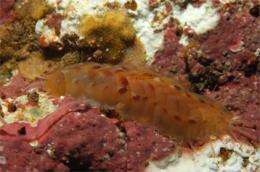Segmentation is the secret behind the extraordinary diversification of animals

Segmentation, the repetition of identical anatomical units, seems to be the secret behind the diversity and longevity of the largest and most common animal groups on Earth. Researchers from CNRS and Universite Paris Diderot have shown that this characteristic was inherited from a common segmented ancestor thought to have lived 600 million years ago and whose presence “changed the face of the world”. This discovery is published in Science on 16 July 2010.
What do centipedes, earthworms and humans have in common? They all feature the repetition of anatomically identical units along the axis running from the front to the rear of their bodies. This characteristic, which researchers call segmentation, is shared by three large groups of animals. It may not be obvious at first glance though, as the repeated segments can be hidden by a shell or be partially fused. The segments are nevertheless present, laid out along the bilateral axis in the trunk, abdomen or thorax.
The first of these animal groups is the arthropods, which include centipedes but also insects, spiders, scorpions and crustaceans, representing by far the largest group of animals on the planet. With the highest number of species and individuals, it makes up nearly 40% of animal biomass. Apart from centipedes, whose segmentation is impossible to miss, arthropods also include grasshoppers, crickets and shrimps. Vertebrates, another highly diverse group, come next. They comprise most familiar animals, including humans, and they represent an evolutionary success. In this group, segmentation is found in the vertebrae of the backbone and, at a finer anatomical scale, in the muscles and nerves that spread from the spinal cord. The final group is the annelid worms, whose body is almost entirely formed of identical segments, such as sea and earthworms. They are also very numerous in terms of species, though much less conspicuous.
These three groups are not closely related to one another. So, where does their segmentation come from? Is it possible that they all inherited this feature from a very distant common ancestor that lived 600 million years ago, before the Cambrian explosion, which produced most of the large animal groups that exist today? Or has segmentation occurred several times during the history of evolution? This is the question addressed by the researchers of CNRS and Université Paris Diderot at the Institut Jacques Monod, because segments seem to offer a significant advantage to the groups that have them, in terms of diversity, longevity and overall evolutionary success.

The researchers found that the genes controlling segment formation during embryo development are almost the same in drosophila (an arthropod) and in annelid marine worms, on which they concentrated their studies. These similarities led them to conclude that the genes had been inherited from a common ancestor, which was itself segmented. It also appears that vertebrates inherited this characteristic from an ancestor they share with the arthopods and the annelids. This is what the researchers are now seeking to confirm.
This work supports the idea that segmentation only appeared once in the history of evolution and that it led to the broad diversity of animal groups possessing it. This old and controversial idea among zoologists, had never been proved until now. But why should segmentation be so advantageous? Over millions of years, and exposure to changing environmental constraints, it is easier for an animal to specialize a segment into a specific tool in response to a need, than to create a whole new organ from scratch. By chance, evolution may have played a winning card with segmentation, which profoundly marked the history of life on Earth. If one day we could play God and create artificial animals or even biomimetic robots, perhaps we too should think about it. But this is still within the realm of science fiction.
More information: Hedgehog signaling regulates segment formation in the annelid Platynereis, Science, 16 July 2010.
Provided by CNRS


















